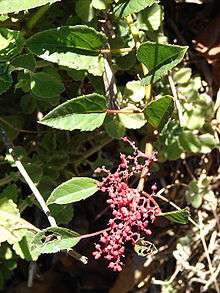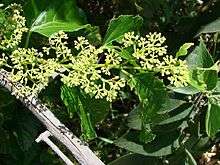Cissus
| Cissus | |
|---|---|
 | |
| Cissus nodosa | |
| Scientific classification | |
| Kingdom: | Plantae |
| (unranked): | Angiosperms |
| (unranked): | Eudicots |
| (unranked): | Rosids |
| Order: | Vitales |
| Family: | Vitaceae |
| Subfamily: | Vitoideae |
| Genus: | Cissus L.[1] |
| Species | |
|
About 350, see text | |

Cissus is a genus of approximately 350 species of lianas (woody vines) in the grape family (Vitaceae). They have a cosmopolitan distribution, though the majority are to be found in the tropics.
Uses
Medicinal
Cissus quadrangularis has been evaluated for potential medical uses. As a source of carotenoids, triterpenoids and ascorbic acid the extracts may have potential for medical effects, including "gastroprotective activity"[2] and benefits in terms of "lipid metabolism and oxidative stress".[3] Cissus quinquangularis was used by the Maasai people of Kenya to relieve some of the symptoms of malaria.[4]
Ornamental
Cissus antarctica, Cissus alata and Cissus incisa are cultivated as garden plants, depending on area of the world. Succulent members of the genus such as Cissus quadrangularis are also found in the nursery trade but tend to be frost tender and are thus not widely cultivated.
Ecology
Cissus species are used as food plants by the larvae of some Lepidoptera species including Hypercompe eridanus and Hypercompe icasia.
Taxonomy
The generic name is derived from the Greek word κισσος (kissos), meaning "ivy".[5] In the 1980s the genus was split according to some details of the flower. The large caudiciform species were moved to the new genus Cyphostemma.
The genus name was established by Carl Linnaeus who used species epithets that are adjectives with feminine grammatical gender in Latin (e.g., C. trifoliata L.). This matches the pattern that names of trees ending in -us in Latin have feminine gender, although other plant names ending in -us are usually masculine.[6]
Selected species
|
Formerly placed here
- Ampelopsis glandulosa var. brevipedunculata (Maxim.) Momiy (as C. brevipedunculata Maxim.)
- Ampelopsis orientalis (Lam.) Planch. (as C. orientalis Lam.)
- Ampelopsis vitifolia Planch. (as C. vitifolia Boiss.)
- Cayratia geniculata (Blume) Gagnep. (as C. geniculata Blume)
- Cayratia trifolia (L.) Domin (as C. trifolia (L.) K.Schum.)
- Clematicissus opaca
- Cyphostemma bainesii (Hook.f.) Desc. (as C. bainesii (Hook.f.) Gilg & M.Brandt)
- Cyphostemma cirrhosum (Thunb.) Desc. (as C. cirrhosa (Thunb.) Willd.)
- Cyphostemma currorii (Hook.f.) Desc. (as C. currorii Hook.f. or C. crameriana Schinz)
- Cyphostemma juttae (Dinter & Gilg) Desc. (as C. juttae Dinter & Gilg)
- Rhoicissus tomentosa (Lam.) Wild & R.B.Drumm. (as C. capensis Willd. or C. tomentosa Lam.)
- Strychnos umbellata (Lour.) Merr. (as C. umbellata Lour.)
- Tetrastigma leucostaphylum (Dennst.) Alston ex Mabb. (as C. lanceolaria Roxb. or C. leucostaphyla Dennst.)
- Tetrastigma serrulatum (Roxb.) Planch. (as C. serrulata Roxb.)[7]
Image gallery
References
| Wikimedia Commons has media related to Cissus. |
| Wikispecies has information related to: Cissus |
- ↑ "Cissus L.". Germplasm Resources Information Network. United States Department of Agriculture. 2006-04-03. Retrieved 2010-07-07.
- ↑ Jainu, M; Mohan, K; Devi, C (2006). "Protective effect of Cissus quadrangularis on neutrophil mediated tissue injury induced by aspirin in rats". Journal of Ethnopharmacology. 104 (3): 302–5. doi:10.1016/j.jep.2005.08.076. PMID 16338111.
- ↑ Oben, Julius E; Enyegue, Damaris; Fomekong, Gilles I; Soukontoua, Yves B; Agbor, Gabriel A (2007). "The effect of Cissus quadrangularis (CQR-300) and a Cissus formulation (CORE) on obesity and obesity-induced oxidative stress". Lipids in Health and Disease. 6: 4. doi:10.1186/1476-511X-6-4. PMC 1800848
 . PMID 17274828.
. PMID 17274828. - ↑ Bussmann, Rainer W; Gilbreath, Genevieve G; Solio, John; Lutura, Manja; Lutuluo, Rumpac; Kunguru, Kimaren; Wood, Nick; Mathenge, Simon G (2006). "Plant use of the Maasai of Sekenani Valley, Maasai Mara, Kenya". Journal of Ethnobiology and Ethnomedicine. 2: 22. doi:10.1186/1746-4269-2-22. PMC 1475560
 . PMID 16674830.
. PMID 16674830. - ↑ Eggli, Urs (2002). Illustrated Handbook of Succulent Plants. 5: Dicotyledons. Springer. p. 452. ISBN 978-3-540-41966-2.
- ↑ Turland, N. (2013), The Code Decoded: A user's guide to the International Code of Nomenclature for algae, fungi, and plants, Regnum Vegetabile Volume 155, Koeltz Scientific Books, ISBN 978-3-87429-433-1 page 96
- 1 2 "Species Records of Cissus". Germplasm Resources Information Network. United States Department of Agriculture. Retrieved 2010-07-07.
- ↑ "Cissus". Integrated Taxonomic Information System. Retrieved 7 July 2010.
_in_Keesaraguda%2C_AP_W_IMG_9153.jpg)
_in_Keesaraguda%2C_AP_W_IMG_9152.jpg)
_in_Keesaraguda%2C_AP_W_IMG_9150.jpg)

